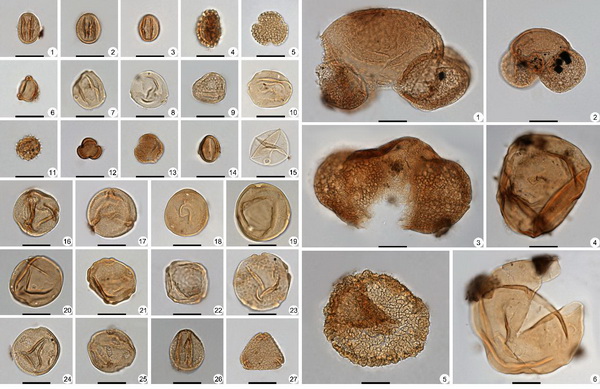
Representative palynomorphs from the Miocene Shengxian Formation in eastern Zhejiang Province (scale bar=20μm)
The Miocene was a period in which significant environmental and climatic changes occurred. Global temperature began to rise since the late Early Miocene, then significantly decreased after the Mid-Miocene Climatic Optimum, which was accompanied by frequent fluctuations. In China, the zonal climate pattern linked to the planetary circulation system was transformed to a monsoon-dominated pattern similar to the present-day one, which had occurred at least by the early Miocene, giving rise to great environment and vegetation changes in this region.
The Neogene Shengxian Formation is a set of strata consisting of basaltic rocks of multi-volcanic cycles and fluvial–lacustrine deposits, the latter is one of the most renowned localities of Neogene fossil plants in China. Isotope chronology studies show the volcanic activities related to the Shengxian Formation occurred during the Late Miocene to the earliest Quaternary, while the fossiliferous horizons are generally assigned to the Miocene which is mainly based on the fossil flora comparisons. Research progress on the palynoflora of the formation is still limited because these deposits either occurred as the intercalations or were formed in small rifted basins and intermontane basins with scattered distribution and small thickness, greatly preventing the accurate correlation among different sections. As sporopollen is an important palaeoenvironmental and palaeoclimatic proxy, it is necessary to establish a possible palynological succession for the in-depth study of the evolution of palaeovegetation and palaeoenvironment in east China.
Recently, a group led by Prof. Wang Weiming from the Nanjing Institute of Geology and Palaeontology, Chinese Academy of Sciences provides a new insight into the palynoflora of the Shengxian Formation and its palaeovegetational and palaeoenvironmental implications. The result was published in “Review of Palaeobotany and Palynology” lately.
According to the division of the volcanic belt within the distribution range of the Shengxian Formation, the research group carried out systematic pollen sampling and analysis. On the basis of compilation of previous studies and extensive correlation with existing sporopollen data, a Miocene palynological succession was established, including the late Early–early Middle Miocene Quercus E.–Liquidambar–Carya assemblage, the late Middle–early Late Miocene Quercus E.–Pinus–(Poaceae)–Trapa assemblage, and the late Late Miocene Quercus E.–Fagus–Artemisia assemblage.
This palynological succession indicates that along with the changes of climate, the vegetation of the study area went through three periods, i.e., thermophilous arbors–dominated stage under the warm and humid climate, conifers–increased and aquatic plants Trapa–flourished stage, forests–shrunk and grassland–expanded stage, which were largely related to the global climate change at that time. Combining with fossil plants records, the zonal vegetation of eastern Zhejiang Province during the late Early–Late Miocene was similar to its modern type but with more distinct altitudinal zonality because of the occurrence of Larix.
This study was financially supported by the National Natural Science Foundation of China, and the Strategic Priority Research Program of Chinese Academy of Sciences.
Download:
